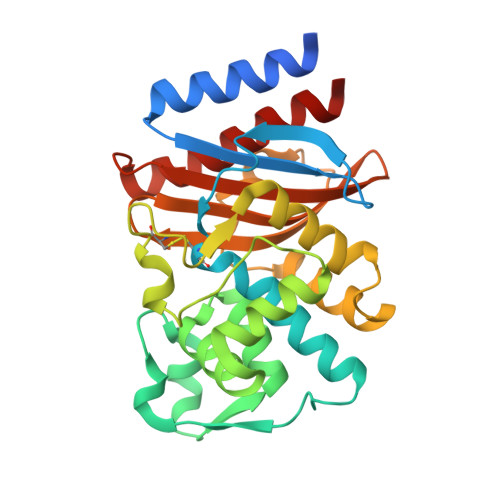Kinetic and crystallographic studies of extended-spectrum GES-11, GES-12, and GES-14 beta-lactamases.
Delbruck, H., Bogaerts, P., Kupper, M.B., Rezende de Castro, R., Bennink, S., Glupczynski, Y., Galleni, M., Hoffmann, K.M., Bebrone, C.(2012) Antimicrob Agents Chemother 56: 5618-5625
- PubMed: 22908160
- DOI: https://doi.org/10.1128/AAC.01272-12
- Primary Citation of Related Structures:
3TSG, 3V3R - PubMed Abstract:
GES-1 is a class A extended-spectrum β-lactamase conferring resistance to penicillins, narrow- and expanded-spectrum cephalosporins, and ceftazidime. However, GES-1 poorly hydrolyzes aztreonam and cephamycins and exhibits very low k(cat) values for carbapenems. Twenty-two GES variants have been discovered thus far, differing from each other by 1 to 3 amino acid substitutions that affect substrate specificity. GES-11 possesses a Gly243Ala substitution which seems to confer to this variant an increased activity against aztreonam and ceftazidime. GES-12 differs from GES-11 by a single Thr237Ala substitution, while GES-14 differs from GES-11 by the Gly170Ser mutation, which is known to confer increased carbapenemase activity. GES-11 and GES-12 were kinetically characterized and compared to GES-1 and GES-14. Purified GES-11 and GES-12 showed strong activities against most tested β-lactams, with the exception of temocillin, cefoxitin, and carbapenems. Both variants showed a significantly increased rate of hydrolysis of cefotaxime, ceftazidime, and aztreonam. On the other hand, GES-11 and GES-12 (and GES-14) variants all containing Ala243 exhibited increased susceptibility to classical inhibitors. The crystallographic structures of the GES-11 and GES-14 β-lactamases were solved. The overall structures of GES-11 and GES-14 are similar to that of GES-1. The Gly243Ala substitution caused only subtle local rearrangements, notably in the typical carbapenemase disulfide bond. The active sites of GES-14 and GES-11 are very similar, with the Gly170Ser substitution leading only to the formation of additional hydrogen bonds of the Ser residue with hydrolytic water and the Glu166 residue.
Organizational Affiliation:
Institute of Molecular Biotechnology, RWTH-Aachen University, Aachen, Germany.
















